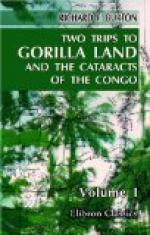The gorilla-hunter’s sketch had always reminded me of the Rev. Mr. Moffat’s account of the Hylobian Bakones, the aborigines of the Matabele country. Mr. Thompson, a missionary to Sherbro ("The Palm Land,” chap. xiii), has, however, these words:—“It is said of the chimpanzees, that they build a kind of rude house of sticks in their wild state, and fill it with leaves; and I doubt it not, for when domesticated they always want some good bed, and make it up regularly.”
Thus I come to the conclusion that the Nchigo Mpolo is a vulgar nest-building ape. The bushmen and the villagers all assured me that neither the common chimpanzee, nor the gorilla proper (Troglodytes gorilla), “make ’im house.” On the other hand, Mr. W. Winwood Reade, writing to “The Athenaeum” from Loanda (Sept. 7, 1862), asserts,—“When the female is pregnant he (the gorilla) builds a nest (as do also the Kulu-Kamba and the chimpanzee), where she is delivered, and which is then abandoned.” And he thus confirms what was told to Dr. Thomas Savage (1847): “In the wild state their (i.e. the gorillas’) habits are in general like those of the Troglodytes niger, building their nests loosely in trees.”
Chapter III.
Geography of the Gaboon.
Before going further afield I may be allowed a few observations, topographical and ethnological, about this highly interesting section of the West African coast.
The Gaboon country, to retain the now familiar term, although no one knows much about its derivation, is placed, by old travellers in “South Guinea,” the tract lying along the Ethiopic, or South Atlantic Ocean, limited by the Camarones Mountain-block in north latitude 4deg., and by Cabo Negro in south latitude 15deg. 40’ 7”, a sea-line of nearly 1,200 miles. The Gaboon proper is included between the Camarones Mountains to the north, and the “Mayumba,"properly the “Yumba” country southwards, in south latitude 3deg. 22’,—a shore upwards of 400 miles long. The inland depth is undetermined; geographically we should limit it to the Western Ghats, which rarely recede more than 60 miles from the sea, and ethnologically no line can yet be drawn. The country is almost bisected by the equator, and by the Rio de Gabao, which discharges in north latitude 0deg. 21’ 25” and east longitude 9deg. 21’ 23”; and it corresponds in parallel with the Somali-Galla country and the Juba River on the east coast.




